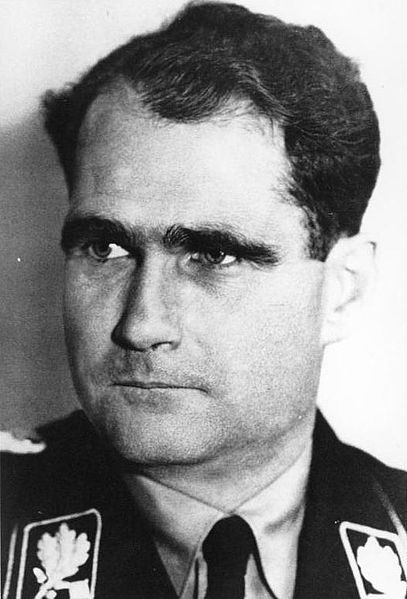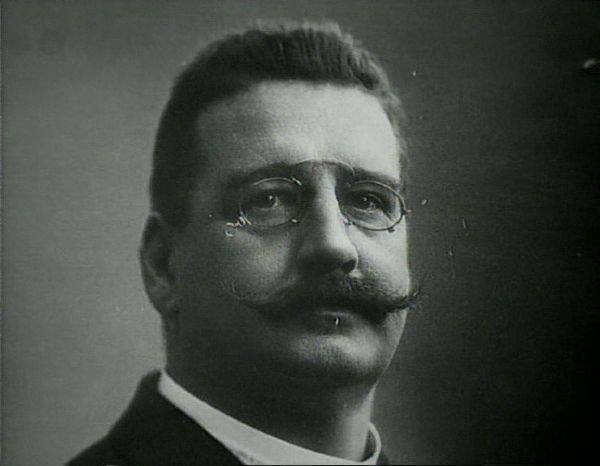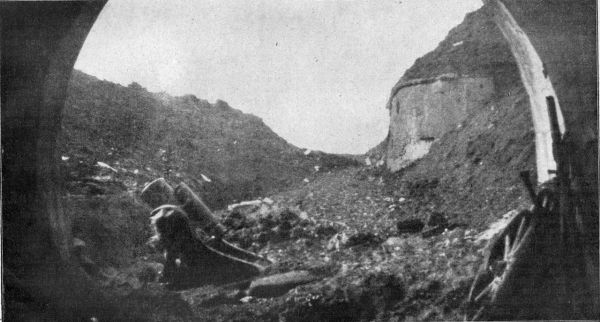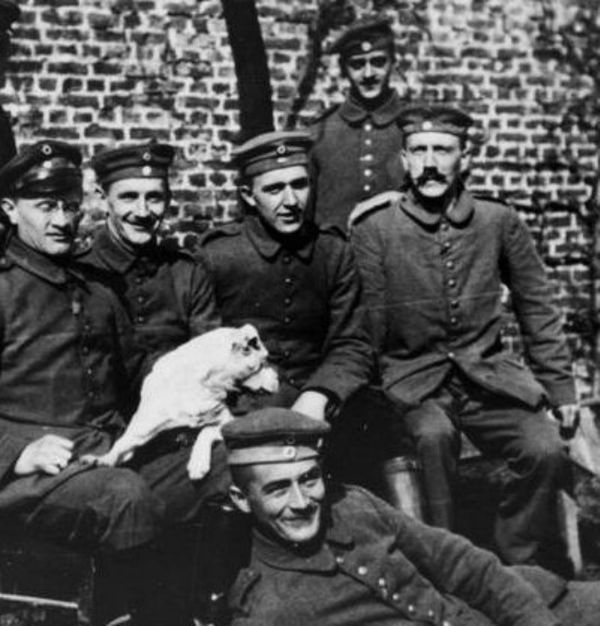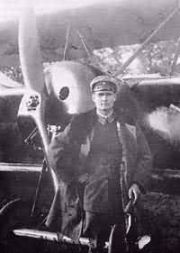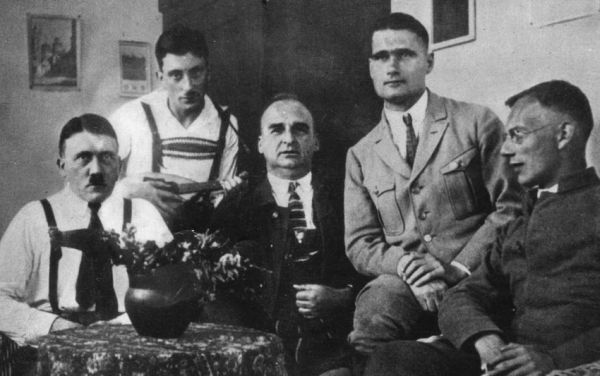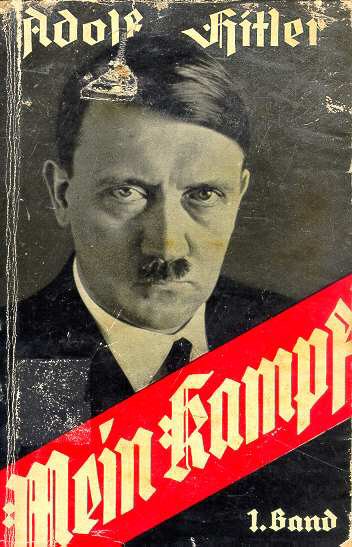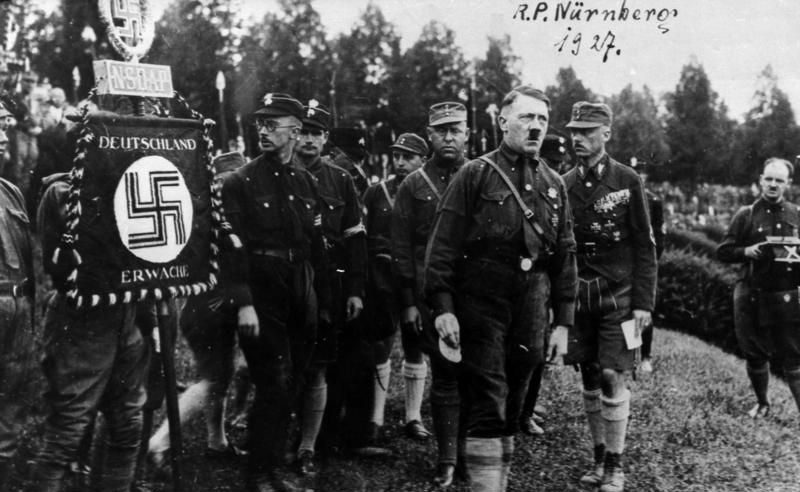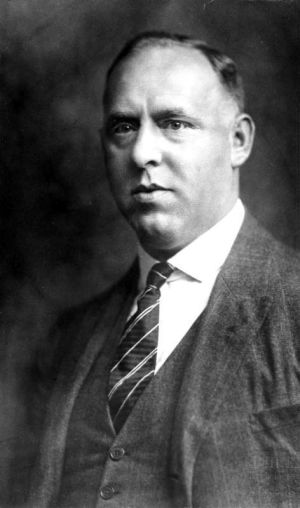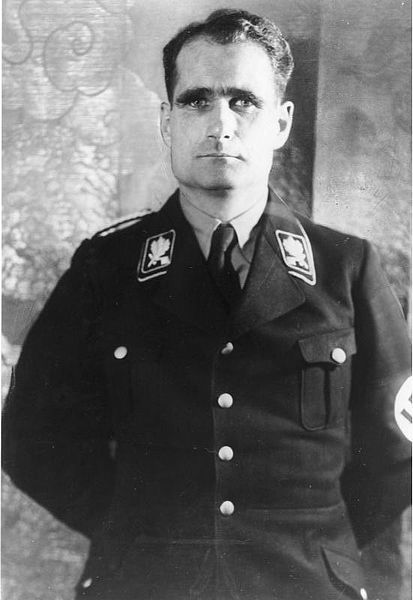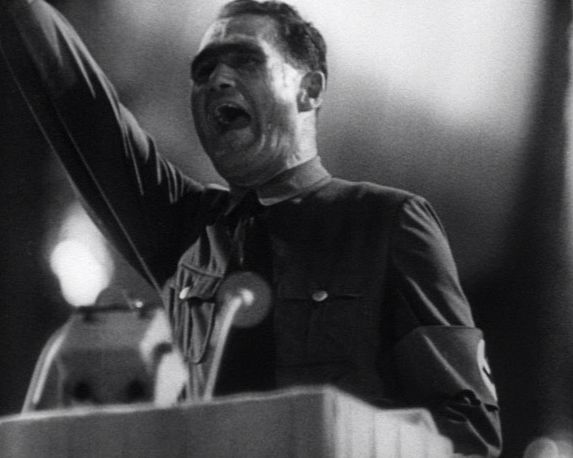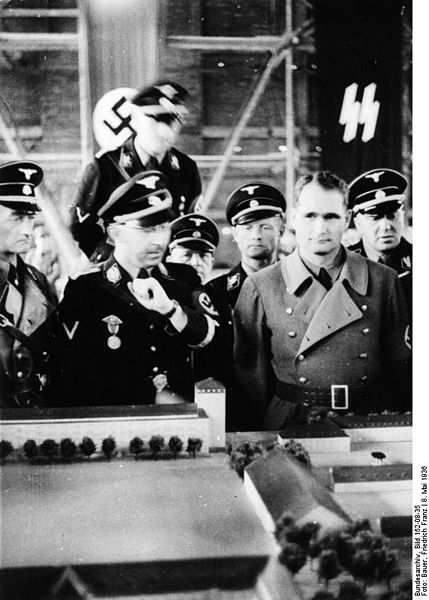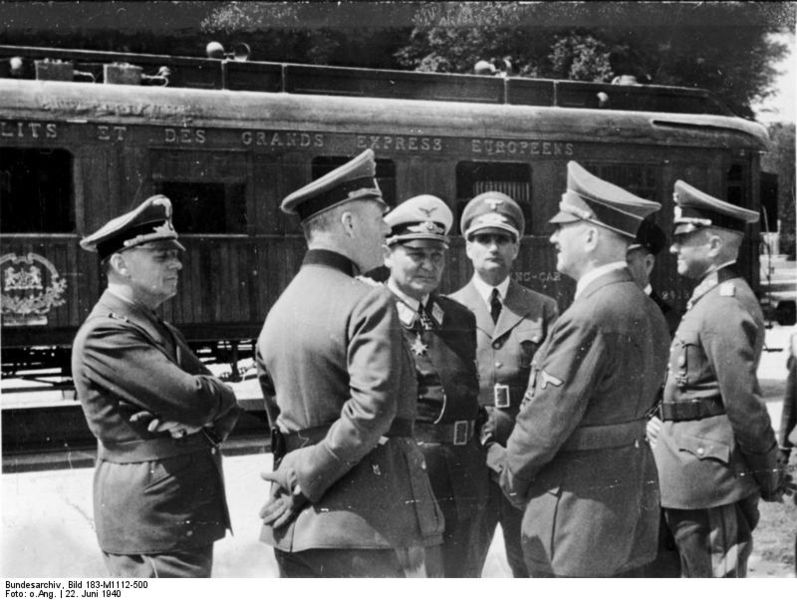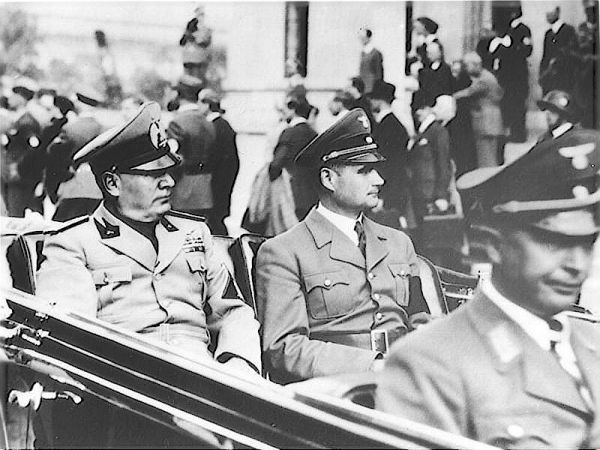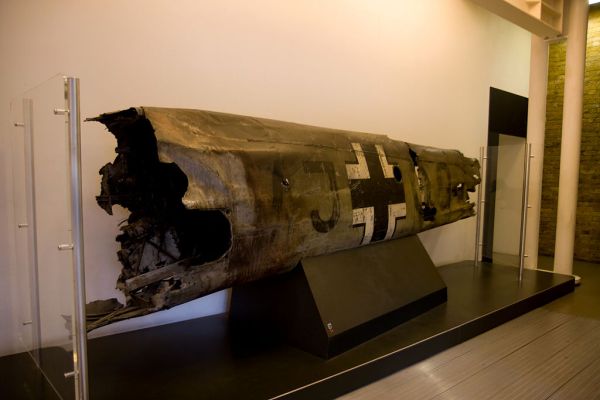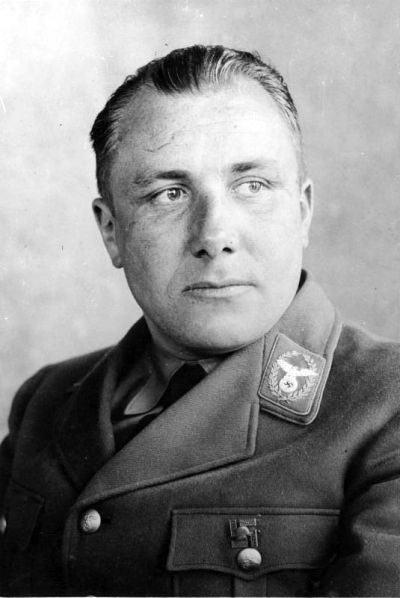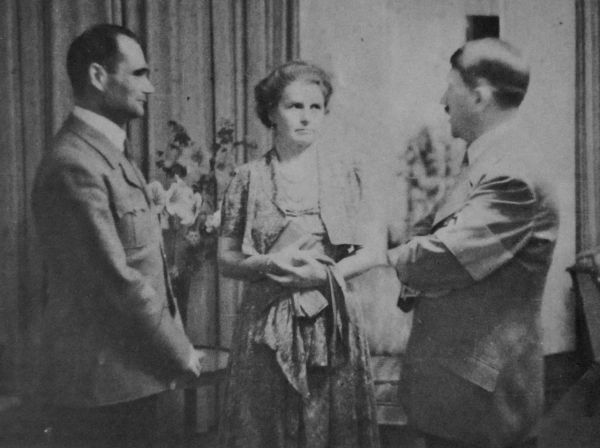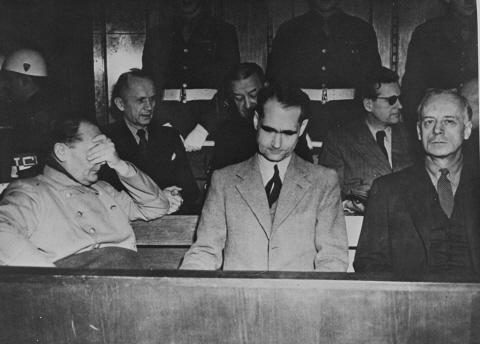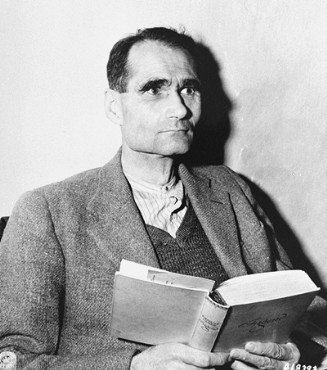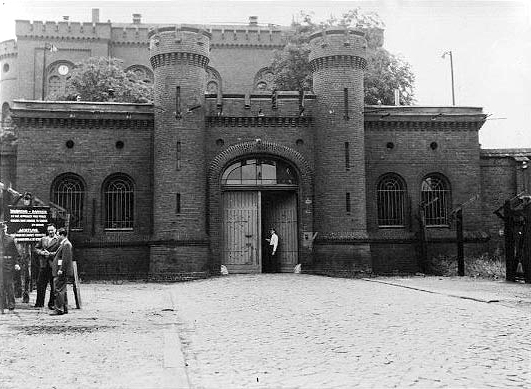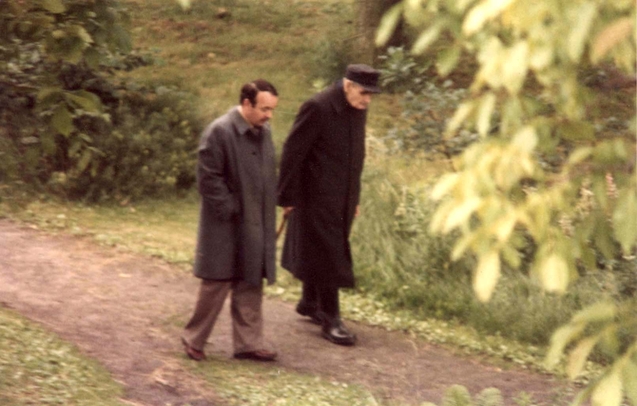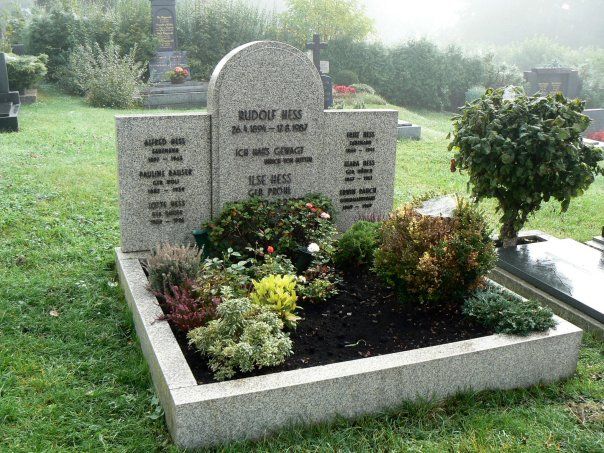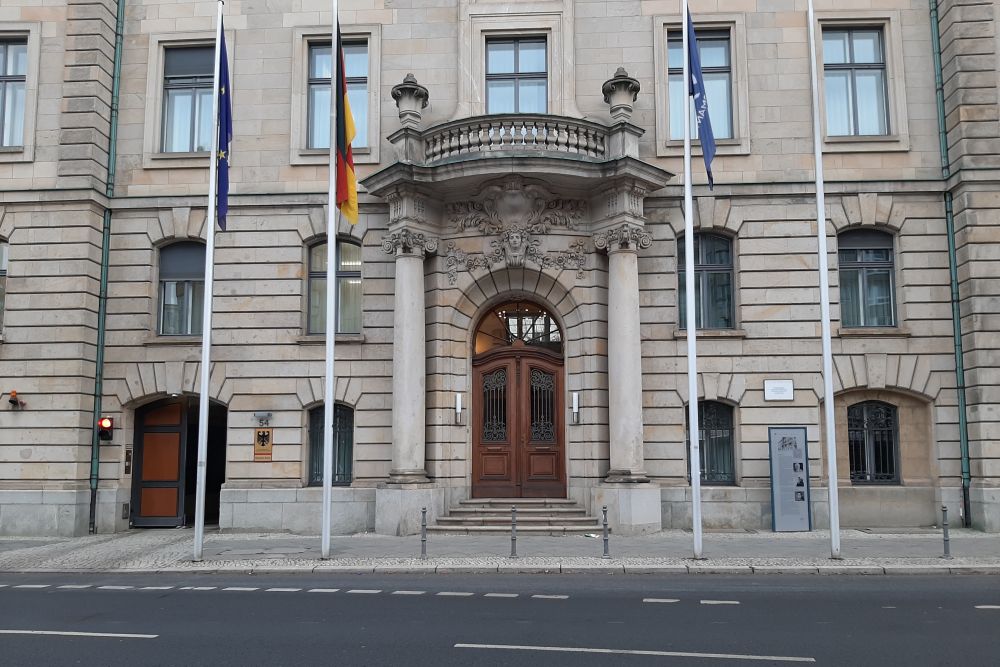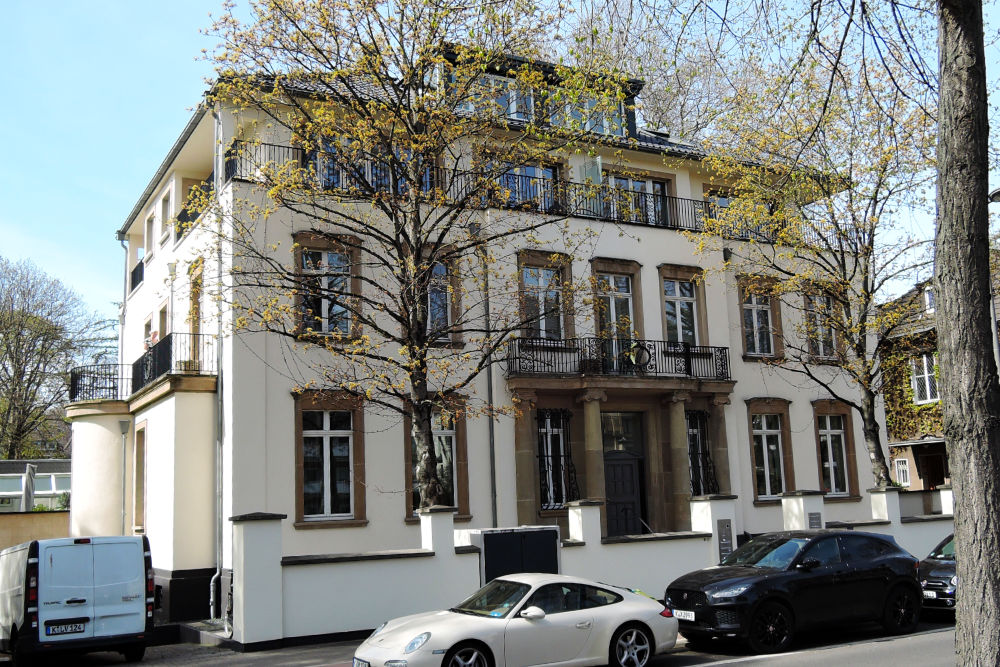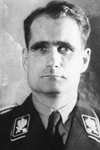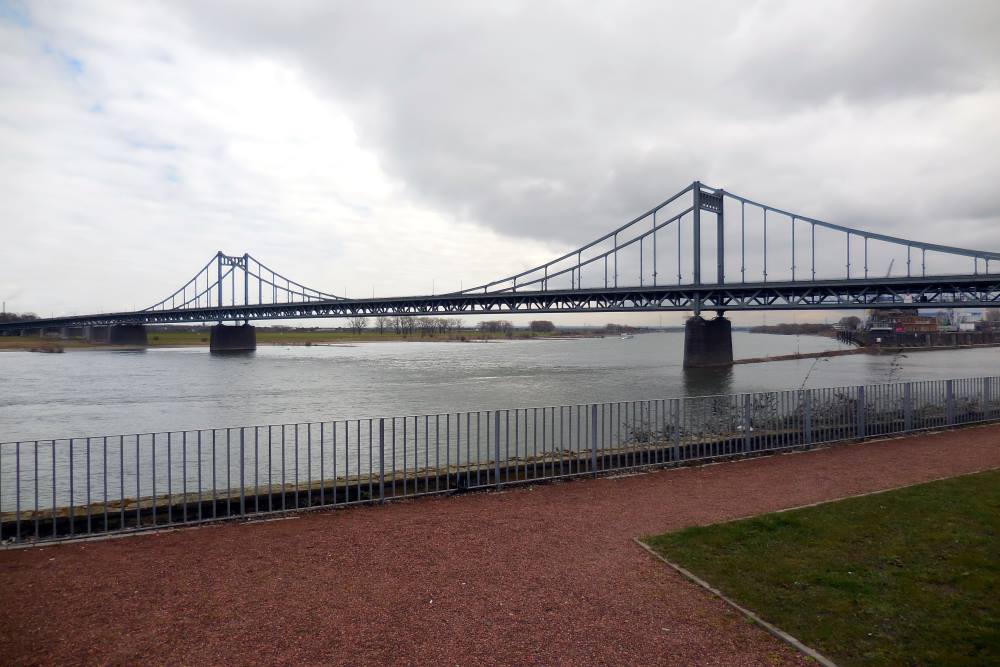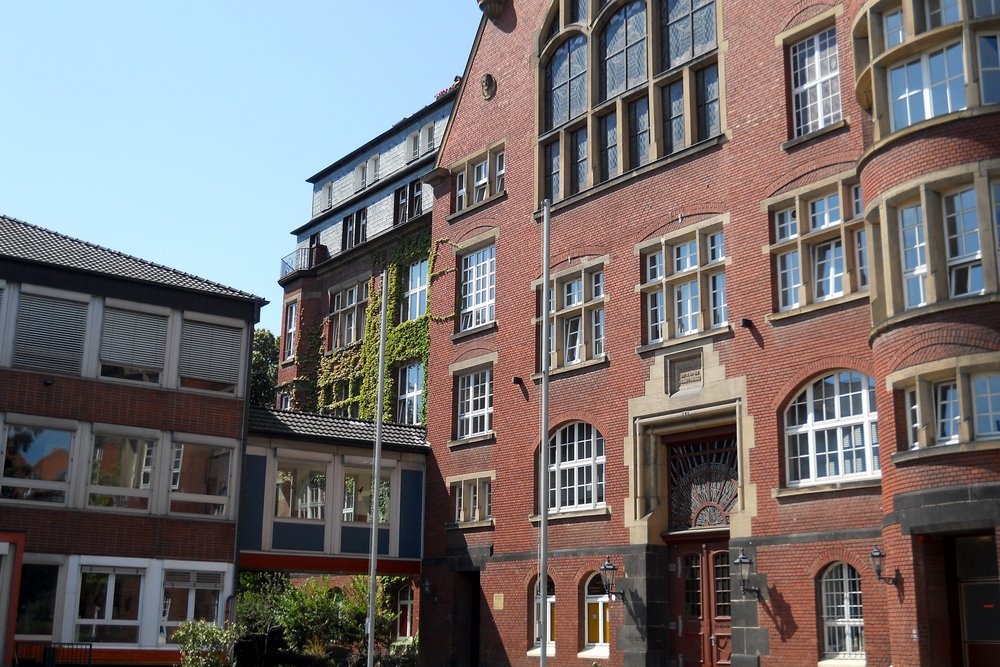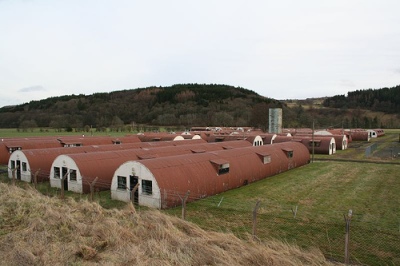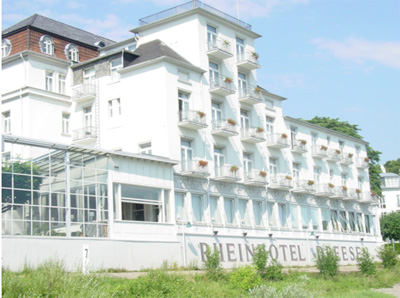Introduction
After the Second World War, no other person has given occassion to so many conspiracy theories as Rudolf Hess. Who was this man who supported Adolf Hitler from the beginning of his political career and his most loyal servant until 1941? His flight to Scotland on May 10th of that year was a complete surprise to each and everyone. Had Hess become insane, as has been argued by many or did he really think he could make peace with Great-Britain?
Images
Childhood and First World War
Childhood
Rudolf Walter Richard Hess was born on April 26, 1894, in Alexandria, Egypt, son of Johan Fritz Hess and Clara Münch. His father was managing director of the importfirm Hess & Co. Rudolf had a junior brother Alfred, born in 1897 and a sister, Margarete, born in 1908. Being the son of wealthy parents, he had a carefree childhood. He received a evangelic and nationalistic education. The German community in Egypt was very strong and patriotic and also very close. Rudolf went to the small schools that had been set up by members of the German community. From the age of 12 onwards, Rudolf was taught by private teachers. The family lived in a villa in Ibrahimieh, a suburb of Alexandria. The family spent summer holidays on an estate in Reicholdsgrün in the Fichtel mountains in northern Bavaria, Germany. Rudolf had a laborious relationship with his stern and authoritarian father. He allowed no arguments and in his upbringing, discipline and obedience stood in the center. The relationshp with his gentle mother was a lot better. He inherited his fascination for the supernatural, astronmy and astrology from her.
In 1908, Hess was sent to a boarding school in Bad Godesberg near Bonn to take up an education at the evangelical Otto Kühnschule (secondary grammar school). He did not return to Egypt. According to most sources, Rudolf showed an above-average intellect and he did well in subjects like natural sciences and mathematics. After graduation Hess really wanted to study engineering but his father disapproved. He insisted Rudolf should take a course at the École Supérieure du Commerce (higher trade school) at Neuchâtel, Switzerland. After graduation, he became a trainee with a trading firm in Hamburg. Hess seemed to have enjoyed himself very much in Hamburg. He played tennis and visited a theatre often. He also read much and in particular books on the nautical history of Germany.
The First World War
When the First World War broke out in August 1914, Hess reported as volunteer in the 7 Königliches Bayerisches Feldartillerie Regiment (Royal Bavarian Fieldartillery regiment), despite disapproval of his father. After basic training, Hess had to perform garrison duties for some time, albeit very reluctantly as he wanted to fight for the Fatherland. This wish of his was fullfilled when he was transfered to the western front. He received his baptism of fire on the Somme, he also took part as infantryman of the artilleryregiment in the first battle of Ypre, which was launched on October 21, 1914.
On November 9th, 1914, Hess was transfered to 1 Bayerisches Infanterie-Regiment (Bavarian Infantryregiment), at that moment stationed in the vicinity of Arras. With this unit he fought on the western front and in Belgium. He considered fighting and risking one’s life for the Fatherland highly honourable. He wrote enthousiastic letters to his parents with phrases like: "Burning villages of exceptional beauty. War!" His comrades described Hess as very courageous, someone who was always at the head of the fighting and who frequently reported as volunteeer to lead a reconnaissance patrol. On April 15, 1915, Hess was promoted to Gefreiter (Corporal). On April 27 he was awarded the Eisernes Kreuz 2 (EK 2, Iron Cross). In August 1915 he went to Münster for advanced military training and in October the same year he was promoted to Vizefeldwebel (Staff Sergeant) and posted back to his regiment in the vicinity of Neuville-Saint-Vaast in Artois. He served here as commander of a shock troop and was injured in his left hand and upper arm during the fighting for Fort Douaumont near Verdun on June 12, 1916.
After recuperation, he was transferred to 18 Bayerisches Reserve Infanterie-Regiment (Bavarian Infantryregiment reserve), stationed in Romenia. On July 23, 1917, Hess was wounded by a shell fragment in his left arm. On August 8th the same year, he was hit in the chest by a sniper. The bullet penetrated his chest and lung. Consequently, Hess remained in various military hospitals in Hungary and Germany between October 10 and December 1917. October 8, 1917 saw him promoted to Leutnant (Lieutenant). On his return he was given command over a reservecompany in the Königliches Bayerisches 16 Reserve-Infanterie-Regiment (Royal Bavarian 16 reserve infantry regiment), nicknamed the List regiment after its first commander. This regiment was known for comprising so many intellectuals and students and also for its extremely high losses. One of the regimental couriers was Gefreiter Adolf Hitler although Hess and Hitler have never met during the war.
Rudolf Hess enrolled in the German air force in 1918. He commenced flight training in March on Fliegerhorst (air base) Lechfeld near Augsburg. Hess received his wings only a few weeks prior to the armistice of November 11, 1918. During the last days of the war he served in the Bayerische Jagdstaffel (Bavarian Fightersquadron) 35. He took part in a number of dogfights over Valenciennes in a Fokker D.VII but did not manage anymore to distinguish himself in this short period. After the armistice, Hess left the army in December of the same year, a disillusioned man.
Hess was shocked by the defeat. In his opinion, the German armed forces were still capable enough to fight. He put the blame for the defeat on the Jews and socialists. They would have stabbed the German army in the back by unleashing revolts in the Fatherland and proclaiming the republic, forcing the military at the front to cease fighting. In his own words, he became a dedicated anti-Semite because of these events in 1919
Definitielijst
- Eisernes Kreuz
- Iron Cross. German military decoration.
- First World War
- Took place from 1914 till 1918 and is also named The Great War. The conflict started because of increased nationalism, militarism and neo-colonialism in Europe. Two alliances battled one another during the 4-year war, which after a dynamic start, resulted into static trench warfare. The belligerents were the Triple Alliance (consisting of Great-Britain, France, and Russia; later enlarged by Italy and the USA, amongst others) on the one hand and the Central Powers (consisting of Germany, Austria-Hungary, Bulgaria and the Ottoman empire) on the other hand. The war was characterized by the huge number of casualties and the use of many new weapons (flamethrowers, aircraft, poison gas, tanks). The war ended in 1918 when Germany and its allies surrendered unconditionally.
- infantry
- Foot soldiers of a given army.
- Iron Cross
- English translation of the German decoration Eisernes Kreuz.
- Jews
- Middle Eastern people with own religion that lived in Palestine. They distinguished themselves by their strong monotheism and the strict observance of the Law and tradition. During World War 2 the Jewish people were ruthlessly persecuted and annihilated by the German Nazis. . An estimated 6,000,000 Jews were exterminated.
- Regiment
- Part of a division. A division divided into a number of regiments. In the army traditionally the name of the major organised unit of one type of weapon.
- sniper
- Military sniper who can eliminate individual targets at long distances (up to about 800 meters).
Images
His idol, Hitler
Member of the NSDAP
After the war, the possessions of the Hess family were confiscated by the British. Financially speaking, Rudolf did a lot worse than before. Despite his situation, Hess was able to start studying at Munich University (Edit: former frontsoldiers were allowed to enter university without having to take an entrance examination). In February 1919, he commenced studies in economy, history and law. Hess led a frugal life: he was a vegetarian, did not drink nor smoke and seldom went out. One of his teachers in university was Professor Karl Haushofer, a former general whose ideas on politics and races made a profound impression on Hess and a close friendship evolved between the two.
In his lectures on geopolitics, Haushofer claimed, among other things, Germany was in need of Lebensraum (space to live) in the East. Hess would terminate his studies in 1925 without obtaining a diploma. Even after his studies, he kept in close contact with Karl Haushofer.
Meanwhile there were very troubled times in Munich. Sympathizers with leftist political ideology and groups of intellectuals had revolted and founded the Munich Radenrepublic. In a reaction, bands of extreme righti were formed, consisting largely of former soldiers. These so called Freikorpses were set on taking harsh action against any form of socialism and communism. In this period, Hess became a member of the Thule Gesellschaft (society). Outwardly, this was a society dedicated to the study of ancient literature but in reality, it was involved in extreme nationalism, radical mysticism (the myths of the German race), occultism and anti-Semitism. Alfred Rosenberg, who would become the ideologist of the NSDAP later on, played an important role in this society. The Thule Gesellschaft maintained close ties with local Freikorpses, including that of Oberst Franz Ritter von Epp. In April-May 1919, this Korps with Hess in its ranks, had been involved in the overthrow of the Radenrepublic in Munich whereby Hess was injured in his leg.
In April 1920, in a guest house where right wing groups often met, Hess came to know a student and his future wife, Ilse Pröhl. On May 19th, 1920, Hess attended a meeting in a beer cellar in Munich of the Nationalsozialistische Deutsche Arbeiterpartei (NSDAP, National socialist German workers Party), a tiny extreme right wing party, founded on February 24, 1920. Here, for the first time, he heard Hitler speak. Later he said about this: "I heard a man speak today and if anyone can free us from the shackles of the Treaty of Versailles, he surely can. This man, this stranger will regain our honour". The impact of this meeting was huge and consequently, on July 1, 1920, Hess became member number 16 of the NSDAP. In the fall of 1920 he founded, with like-minded people, the 1 Münchener NS Studentensturm (Munich Nazistudent group), predecessor of the future national socialist student unions.
Hitler and Hess immediately got along quite well. Hess was polite, good natured and was a good listener. He quickly grew into the personal assistant of the man who would take definite charge of the party in June 1921 and he accompanied him regularly. Hess was deeply impressed by the charismatic leader and he was the first to address him as Führer. The German historian Guido Knopp writes that Hess was always on the look out for an authoritarian figure to guide him. Initially, that was his father, then his superiors in the army and finally it was Adolf Hitler.
Together with his girlfriend Ilse, Hess distributed pamphlets and posters for the party. He also participated in the brawls between supporters of the NSDAP and political opponents, especially communists and socialists. He fought with total devotion against those who tried to violently disrupt Hitler’s meetings and speeches. Once, Hess was bashed with a beercan, leaving him with a gaping headwound. In 1922, Hess became a member of the Sturmabteilung (SA, storm troopers) the paramilitary fighting force of the NSDAP.
During the attempted coup on November 8 and 9, 1923 in Bavaria that was carried out by the party and led by Hitler, it was Hess’ task to stand guard over the ministers who had been taken hostage, including the conservative Prime Minister of Bavaria, Eugen Ritter von Knilling. Consequently, he was not present at the Bierhalle Putsch (coup of the beer hall) when the Bavarian police put a bloody end to it, resulting in 16 members of the NSDAP and four police officers dead. Later, on November 11, Hitler was arrested. When Hess heard of the failure, he fled with his hostages but they managed to escape. The escaped Nazi then went into hiding in Austria and later with the Haushofer family in the Bavarian Alps. Here he resumed his studies that he had neglected in the previous period.
When Hess learned that Hitler had been condemned to a relatively light sentence of five years in prison, he decided he would give himself up to the police, reasoning: "I can’t get it any worse than my master". For his participation in the coup, Hess was sentenced to 18 months in jail. Just like Hitler, he was sent to Landsberg prison to serve his sentence. The conditions in this prison were remarkably comfortable. Hess and Hitler both had a spacious cell, they were allowed to receive visitors and enjoyed much freedom within the prison. During his post war imprisonment in Spandau prison, Hess often recalled it in sadness.
In prison, the future dictator started to write his book "Mein Kampf" (My struggle). Many sources claim Hitler dictated this book in large measure to Hess. This is not true however. Research by historian Othmar Plöckinger shows that the first part of Mein Kampf had already been written by Hitler even before Hess was interned in this prison so he can’t have contributed much to this part. It is probable however that the concept of Lebensraum was included in this book on instigation by Hess. He was also charged with editing the second part of Mein Kampf. Remarkably, Plöckinger discovered that Ilse Pröhl, Hess’ future wife, has also been involved in the origin of this book by Hitler. Her contribution however was not so large and consisted mainly of small alterations in content and style.
The relationship between Hitler and Hess was to grow even stronger in Landsberg. He acted as Hiter’s partner in conversation and his proof reader. Hess may have made some suggestions to be included in Mein Kampf. From prison, Hess wrote about Hitler to a family member: "I am more than ever dedicated to him, I love him".
Hitler’s secretary
After his release in early 1925, Hess was employed as Hitler’s personal secretary for a few years, although he did not have an official rank within the party. After Hitler had been discharged from prison he took it on himself to gain power the legal way. He re-organized the party and after the ban on the NSDAP, which had been imposed in November 1923 was lifted in February 1925, he and the party took part in regional and general elections. The first years brought little success to the party however. In his capacity as secretary, Hess was continuously in Hitler's vicinity. He kept the agenda, organized party meetings, answered letters and accompanied Hitler on his campaign tours. Persons who had requested a meeting with the partyleader had to see Hess first before meeting the Führer himself.
Hess shielded Hitler from the bickering that went on amongst the party officials; in fact he acted as something like a mediator between Hitler and the party. The fact that Hess was continuously in Hitler’s vicinity evoked jealousy in others. Due to his submissive and servile attitude towards Hitler, they already called him "Das Fraulein" (Miss). Ernst Hanfstaengel, partymember and sponsor of the party described Hess in those days as "a bad tempered introvert who became extremely jealous of anyone who approached Hitler too closely". Because of his love-hate relationship with Hitler, charges of homosexuality were also brought against Hess. On December 20, 1927, on Hitler’s instigation, Hess married the aforementioned Ilse Pröhl, whom he had met in Munich in the early 20s. The witnesses were Hitler and Haushofer. The couple moved into a villa in Harlaching, a suburb of Munich in 1933. Later, on November 18, 1937, their son, Wolf Rüdiger Hess would be born.
Meanwhile, Hess busied himself with fund raising for the party among the German captains of industry. He was very successful in this. Hess was a former officer and came from wealthy circles, he wa a gentleman and consequently could get along well with factory owners and bankers, causing the funds of the party to increase considerably. Despite his busy work for Hitler, Hess continued to pursue his great hobby: flying which he had learned in World War One. He regularly took part in air races and even fostered plans to cross the Atlantic. In 1930 he received his own airplane which he used, among other things for purposes of advertising and campaigning and the partypaper "Der Völkische Beobachter" (People’s observer).
Definitielijst
- Bierhalle Putsch
- The nickname for the failed coup d’état by the NSDAP on 8 and 9 November 1923, named after the Bürgerbräukeller. Germany was on the brink of economic collapse and social unrest was tremendous. In Bavaria a putsch was decided but due to lack of leadership Adolf Hitler chose to adopt the putsch hoping that he would be chosen as leader. The putsch however was opposed and when Hitler found out he rallied a march to get the masses on the barricades. The police shot up the march and the coup d’état was suppressed. Hitler fled the scene but was arrested on 11 November.
- communism
- Political ideology originating from the work of Karl Marx “Das Kapital” written in 1848 as a reaction to the so-called class struggle between the proletariat (labourers) and the bourgeoisie. According to Marx the proletariat would take over power from the well-to-do classes though a revolution. The communist movement aspires an ideal situation where the means of production and the means of consumption are common property of all citizens. This should end poverty and inequality (communis = common).
- Führer
- German word for leader. During his reign of power Adolf Hitler was Führer of Nazi Germany.
- ideology
- A collection of principles and ideas of a certain system.
- Lebensraum
- “Living space”. Nazi term indicating the need for the overpopulated German lands to expand.
- Mein Kampf
- “My Struggle”. Book written by Adolf Hitler, outlining the principles of National Socialism.
- nationalism
- The pursuit of a people to become politically independence or securing such independence.
- Nazi
- Abbreviation of a national socialist.
- NSDAP
- Nazi Party, byname of National Socialist German Workers' Party, German Nationalsozialistische Deutsche Arbeiterpartei (NSDAP), political party of the mass movement known as National Socialism. Under the leadership of Adolf Hitler , the party came to power in Germany in 1933 and governed by totalitarian methods until 1945.
- Putsch
- Coup, often involving the use of violence.
- socialism
- Political ideology aiming at slight or no class differences. Means of production are owned by the state. Evolved as a response to capitalism. Karl Marx tried to substantiate socialism scientific.
- Sturmabteilung
- Storm detachment. Semi-military section of the NSDAP. Founded in 1922 to secure meetings and leaders of the NSDAP. Their increasing power was stopped during “The night of the long knives”, 29 and 30 June 1934.
- wa
- Abbreviation of defence department, assault groups of the NSB
Images
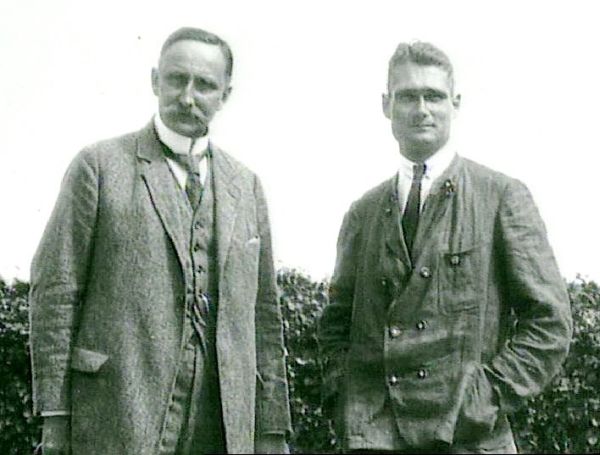 Hess with his friend and mentor Professor Karl Haushofer in 1921. Source: Bundesarchiv / Wikimedia Commons..
Hess with his friend and mentor Professor Karl Haushofer in 1921. Source: Bundesarchiv / Wikimedia Commons..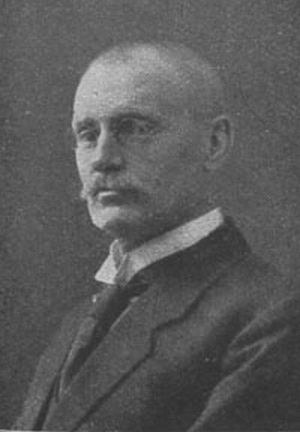 Eugen Ritter van Knilling, Bavarian Prime Minister. During the Bierhalle putsch of 1923, he was taken hostage and guarded by Hess. Source: Historisches Lexikon Bayern..
Eugen Ritter van Knilling, Bavarian Prime Minister. During the Bierhalle putsch of 1923, he was taken hostage and guarded by Hess. Source: Historisches Lexikon Bayern..Career in the Nazi Party
Vorsitzender der Politische Zentralkommission der NSDAP (Chairman of the central political commission of the NSDAP)
In these years, Hess enlarged the Parteikanzlei (party chancellory), the administrative heart of the party, until May 1941 designated the Stab des Stellvertreters des Führers (staff of the Führer’s deputy). In 1931, this organization moved into its own offices in the so called Braunes Haus (brown house) in Munich, the party headquarters. In the meantime, Hess had also become a member of the SS. The successes of the party increased. Membership of the NSDAP gradually increased to 1,500,000 in 1929. After the crash of the Stock Exchange in October of that year and the ensuing economical crisis, the party really started to expand. In September 1930, the party won 18.3 % of the votes in the elections for the Reichstag. On July 1st, 1932, the party won no less than 37.3% of the votes but Hitler did not yet become Reichskanzler (state chancellor); especially as the Reichspräsident (State president), the old general Paul von Hindenburg prevented this.
Hess fell ill in September 1932 and had to recuperate in a hospital for a few months from a boil infection. In November 1932, the party lost 2,000,000 votes in the election for the Reichstag but retained 33.1 % of the votes, still making it the largest party in Germany.
The NSDAP threatened to fall apart however when it turned out that Reichsorganisationssleiter (head of organization), Gregor Strasser, one of the Old Warriors and up till then a confidant of Hitler’s and who advocated a more socialist policy, had entered into negotiations, behind Hitler’s back, with Kurt Schleicher who had been appointed Reichskanzler by Von Hindenburg on December 3rd . Strasser attempted to split the party apart and subsequently form a government in co-operation with Von Schleicher. Eventually, no split occurred as on December 8, 1932, Hitler forced Von Schleicher to leave the party and he appointed Hess as chairman of the newly established central political commission of the NSDAP, a position comparable to that of a secretary-general. By this move, Hess became, at least in theory, the second most powerful man in the party with one stroke. In December 1932, Heinrich Himmler, chief of the SS, granted Hess the rank of SS-Gruppenführer as well, which meant he was permitted to wear the SS uniform. In the following year he was promoted to SS-Obergruppenführer.
Stellvertreter des Führers (the Führer’s deputy)
After the elections in November 1932, in which the communists achieved a sizeable victory, fear for a revolution increased in Germany. Hitler turned this fear to his advantage and threatened that the communists would seize power unless he was appointed Reichskanzler. On January 4, 1933, conservative politician Franz von Papen entered into negotiations with Adolf Hitler to try and form a government. The country already suffered from a political crisis for months. On January 30, 1933, Reichspräsident Von Hindenburg bowed to the pressure that mainly came from prominent industrialists and estate owners and he appointed Hitler Reichskanzler. Because of the fire in the building of the Rechstag on February 27, 1933 and the subsequent proclamation of the Emergency Law, prohibiting all resistance and the Authorisation Law that was passed on March 23, Hitler was able to seize all power and establish the Third Reich.
On April 21, 1933, Hitler appointed Hess Stellvertreter des Führers (the Führer’s deputy). This position did not carry real power but now, Hess was allowed to attend meetings of the cabinet. In December 1933, he finally became member of the cabinet after he was appointed Minister without Portfolio. As the Authorisation Law was passed on March 24th, 1933, the unification of party and State became a reality. From then on, the government did not have to lay its decisions before the parliament for verification, effectively side tracking the Reichstag. From that day on, Hitler was able to yield his power by issuing decrees. As Hess was in charge of the central commission, his tasks consisted mainly of checking and converting these decrees into official language. Hess also supervised the Germans who were living abroad and the Auslandorganisation (AO, foreign agency) of the NSDAP. Furthermore, Hess was authorized to enter into negotiations with other countries on behalf of Hitler.
In his new functions, Hess was obliged to appear more and more in public. Despite the fact that he was a poor speaker, he soon did become one of the most popular figures of the regime. Probably because he was seen as the epitome of decency: he was incorruptable, reliable and direct and that set him somewhat apart from other important Nazis as Hermann Göring and Josef Goebbels. Among others, it was Hess’ task to anounce Hitler at the Reichsparteitage (days of the party) as can be seen in the documentary Triumph des Willens (triumph of the will) by Leni Riefenstahl and to direct the ceremony of oath taking to Hitler. He frequently used phrases like: "Die Partei ist Hitler, Hitler ist aber Deutschland wie Deutschland Hitler ist" (Hitler is the Party but Hitler is Germany just like Germany is Hitler) and: "Our nationalsocialism is anchored in blind docility, in devotion to the Führer whom one does not ask why and for whom one does in silence whatever he orders". The German historian Guido Knopp describes Hess in his role in the adoration of the Führer as the "high priest of the Hitler cult".
Hess was in charge of the entire body of partyofficials. As the NSDAP evolved into a state within the state and all sorts of functions arose with overlapping power, Hess almost drowned under the workload. He was not able to solve the problems and he let himself be fooled regularly by the Gauleiter (regional partyleaders) and other party officials. Almost all complaints that came to the party chancellory were dealt with by Hess personally. Partly owing to this, he was designated as the conscience of the party. His usual answer however was always that he would look the case over again. The following phrase that circulated was allegedly about Hess: "Come to me, all those who are tired and stressed and I shall do absolutely nothing". As Hess could not perform his duties properly anymore, he decided to employ a chief of staff. June 1933, he appointed Martin Bormann, a rising star within the party. In this fuction. Bormann performed his duties well, relieving Hess of much of his work. Later it would turn out that Bormann had been coveting the position of the Füher’s deputy from the very beginning.
Despite the fact that Hess held an important position within the party, he had little power in comparison to the other top Nazis like for instance Hermann Göring and Heinrich Himmler. In his position he could hardly take any initiative himself as his functions were more of a representative nature and he had to share his power with others. In addittion to that, Hess possessed little personal ambition. He had a somewhat naïve character and did not strive after power or luxury; being a faithful servant and being in Hitler’s favour was more important to him. The fact that Hess joined the Geheime Kabinettsrat (secret ministerial council) in February 1938 and became a member of the Reichsverteidigingsrat (council for national defence) in August 1939 made little difference. Both councils had more of a symbolic function without having any power of decision; moreover, Hess seldom attended the meetings.
The limited influence of Hess became obvious when he was not informed in advance of the Night of the Long Knives. During this bloodbath, which occurred in the night of June 30 - July 1, 1934, the entire top of the SA was murdered because Hitler did not trust the organization any longer. The SA had served Hitler well but once he had risen to power, the organization became more and more repugnant to him. The leader of the organization, Ernst Röhm wanted his SA to take the place of the German army. Moreove, Hitler was called on to do something about the aggressive and uncoordinated conduct of this paramilitary unit. Other opponents of Hitler’s were also murdered, including Gregor Strasser. Although Hess was angry over the fact that he had not been informed beforehand, later he did co-operate in explaining away this action.
Meanwhile, Hess started to show an increasing interest in the supernatural. He had always practised astrology - he was convinced that the future could be determined by reading the stars. But now he began to show interest in other occult things like the divining rod. Before he went to sleep, he always checked his room for waterveins (subterranian streams of water with negative radiation). Hess suffered from inexplicable abdominal and intestinal pains which he could not shed, despite numerous medical treatments and adapted food. He visited prayer healers, magnetizers and all kinds of alternative healers. His interest in the supernatural caused his esteem within the party to decrease. Many people claimed that Hess was going nuts. Hermann Göring said about him: "For as long as I have known Hess, he was already a little deranged. His appointment by Hitler to deputy party leader was a mystery to many. I have always thought it was caused by Hitler’s loyalty to old friends".
Hess’ popularity did not increase either when he instructed the Gauleiter to abstain from alcohol, not to make themselves guilty of sexual escapades any longer and to do physical exercise for an hour a day. He also came into conflict with Hitler when he brought his own food to a dinner on the Obersalzberg because, in his opinion, it was more biologic and dynamic. Hitler was not pleased at all and it caused an estrangment between the two old comrades. This conflict was probably also caused by Hess’ strange behaviour becoming more and more repugnant to Hitler.
Definitielijst
- brown house
- Society house of the national-socialist movement.
- Führer
- German word for leader. During his reign of power Adolf Hitler was Führer of Nazi Germany.
- Gauleiter
- Leader and representative of the NSDAP of a Gau.
- Night of the Long Knives
- Night of 30 June to 1 July 1933 during which Hitler killed many of the demanding leaders of the SA, including Ernst Röhm.
- NSDAP
- Nazi Party, byname of National Socialist German Workers' Party, German Nationalsozialistische Deutsche Arbeiterpartei (NSDAP), political party of the mass movement known as National Socialism. Under the leadership of Adolf Hitler , the party came to power in Germany in 1933 and governed by totalitarian methods until 1945.
- resistance
- Resistance against the enemy. Often also with armed resources.
- revolution
- Usually sudden and violent reversal of existing (political) the political set-up and situations.
Images
Anti-Semitism and Second World War
Anti-Semitism
With his speeches and his work in the central commission, Hess did contribute to the fast rising anti-Semitism in Germany during the 1930s. On May 15, 1934, Hess was put in charge of the Rassenpolitisches Amt der NSDAP (department of racial policy). In this capacity he was involved in the proclamation of anti-Semitic measures, such as prohibiting party members to associate with Jews and the disbarring of Jewish lawyers. The Nürnberger racial laws were drafted by this party agency and some of them were written by Rudolf Hess himself. Later he issued the decrees imposing exceptional penal law on Poles and Jews. In 1936 he also paid a visit to Dachau concentrationcamp where he was shown around by Heinrich Himmler himself.
Despite his strong avulsion for Jews, Hess was shocked by the Kristallnacht of November 9 and 10 , 1938, during which Jewish shops were destroyed on a large scale, synagogues set on fire and people tortured and killed. These vandalic actions went straight against the bourgeoise nature of Hess. He sent a message to the Gauleiter, calling on them to curb the violence but nothing was done. Again proof for the fact that his influence was decreasing. He was steadily given more representative functions. He was usually shut out from important meetings. Therefore, he seldom talked with his Führer. As deputy of the Führer in foreign affairs, he did however sign the law that legalized the Anschluss (unification) of Austria and Nazi Germany. He also took part in the negotiations with Czechoslovakia, leading to the annexation of the Sudetenland in 1938 and the remaining parts of the country in March 1939.
The beginning of World War Two
On September 1, 1939, the day on which Nazi Germany invaded Poland and unleashed the Second World War, Hitler named Rudolf Hess his second successor after Hermann Göring. This was no more than a ceremonial act that did not carry addittional power. Hitler himself would have declared: "I only hope that Hess never has to succeed me, I would not know who to pity more then, the party or Hess"
.On September 3rd, 1939, Great-Britain and France declared war on Germany because of the invasion of Poland. This was a setback for Hitler who had never expected that the Allies would go to war over Poland. Hitler saw Great-Britain as Germany’s natural ally, as he had written in Mein Kampf. Germany’s real enemy was in the east, in the form of the Soviet Union. At that time, Hess may have gotten the idea to try and make peace with Great-Britain. He seems to have offered to join the Luftwaffe as a fighterpilot but Hitler forbade this and banned him from flying.
Initially, the war progressed highly successful for the Third Reich. Poland, Denmark, Norway, Belgium, the Netherlands and Luxemburg were all captured by the Wehrmacht. In June 1940, Germany even settled an account with arch enemy as France officially surrendered on June 22nd, 1940. Hess, in his capacity as deputy party leader, attended this ceremony in Compiègne. Despite the great success of Blitzkrieg, Hess remained convinced that peace had to be made with Great-Britain. He considered it strange that two Germanic nations were fighting each other, whilst the real enemy was in the east in the form of the bolsjevist Soviet Union. By achieving this peace, he probably hoped he could regain Hitler’s favour.
He made his first attempt through the German diplomat Albrecht Haushofer, the son of his former teacher. Hess tried to contact Douglas, Duke of Hamilton via Portugal. Why Hess choose exactly this person is not entirely clear. Hess had met the Duke during the Olympic Games of 1936 in Berlin. The Duke however did not hold an important position in the British government. He was however an opponent of Winston Churchill’s and an advocate of peace. Hess probably overestimated the influence and power of this duke. On September 23rd , 1940, Albrecht Haushofer sent a letter to an acquaintance in Lisbon, Violet Roberts, who was to forward an enclosed message to the Duke of Hamilton. However, the message was intercepted by the British Secret Service MI5 and Douglas Hamilton would never receive it. The exact progress of the attempts at negotiations between Great-Britain and Germany is hard to ascertain as the files concerned are still classified in British archives.
At that moment, a plan began to arise in Hess to fly to England himself. Hitler was not aware of these plans. Hitler himself probably made an attempt to try and negotiate with Great-Britain. In his book The last witness" Rochus Misch, Hitler’s bodyguard describes the following event that took place in November 1940: "Towards the end of the meal, a courier handed a telegramme to Reichspressechef (chief of the press) Otto Dietrich. He read it quickly and then passed it on to Hitler. After he had read the message standing up, he called out: "My God, what do they all want from me? I can’t very well fly there and get down on my knees?’ I did not know what was going on but as it was discussed afterwards, I could catch some bits and pieces. I understood it concerned a meeting between the military attaché Enno Emil von Rintelen - whom we called Hitler’s postman - and his Swedish collegue Count Bernadotte in Portugal. Only later I heard of rumours about secret negotiations with the British. Anyway, I remember Hess reacting at some point in time to something Hitler had said. He did not turn to Hitler but to his adjutant and said something like: "Maybe he can’t go. But I, I can".
With help from the factory in Augsburg, Hess managed to get his hands on a Messerschmidt Me 110. He argued he needed this aircraft for testing. He had the plane fitted with addittional fuel tanks and had radio and navigation equipment converted. Hess’ servant, Josef (Sepp) Platzer found a farm in Austria where Hess could prepare himself for his flight. Using his contact Hans Bauer, Hitler’s pilot, Hess obtained maps of the German air space. Hess also pored over English history and language. Apart from that, he wrote a speech he intended to deliver to British officers.
Definitielijst
- Anschluss
- The joining of Austria to Germany. The annexation of Austria by Nazi Germany on 12 March 1938. Austria became part of Greater Germany.
- Blitzkrieg
- The meaning of this word is “Lightning War”. Short and fast campaign. As opposed to a trench war the Blitzkrieg is very quick and agile. Air force and ground forces work closely together. First used against the Germans (September 1939 in Poland.
- Führer
- German word for leader. During his reign of power Adolf Hitler was Führer of Nazi Germany.
- Gauleiter
- Leader and representative of the NSDAP of a Gau.
- invasion
- Armed incursion.
- Jews
- Middle Eastern people with own religion that lived in Palestine. They distinguished themselves by their strong monotheism and the strict observance of the Law and tradition. During World War 2 the Jewish people were ruthlessly persecuted and annihilated by the German Nazis. . An estimated 6,000,000 Jews were exterminated.
- Luftwaffe
- German air force.
- Mein Kampf
- “My Struggle”. Book written by Adolf Hitler, outlining the principles of National Socialism.
- Nazi
- Abbreviation of a national socialist.
- Soviet Union
- Soviet Russia, alternative name for the USSR.
- Wehrmacht
- German armed military forces, divided in ground forces, air force and navy.
Images
Peace mission
Flight to Scotland
January 10, 1941, Hess made his first attempt to fly to Scotland. Prior to departure he gave two letters to his adjutants Karl-Heinz Pinch and Alfred Leitgen, to be opened only after his departure; one of them was addressed to Hitler. After having taken off from an airfield near Augsburg, he landed almost immediately. His fellow workers later suggested that Hess might have lost his courage. In February he made a second attempt from the same location. After about 15 minutes however he was forced to return because of bad weather.
On May 10, 1941, Hess made a third attempt, he took off from Augsburg at 17:45. In his fighterplane, especially equipped for the long flight with two addittional fuel tanks, he covered the more than 932 miles over the North Sea to Dungavel House, the residence of the Duke of Hamilton near Strathaven, not far from Glasgow. He wanted to propose to this man to to use his influence on British politics to come to a peace treaty between Great-Britain and Germany, because Germany stood on the brink of plunging into a war on a second front by launching Operation Barbarossa. Hess wanted to prevent a war on two fronts; a war he probably knew, Germany could never win. Hess hoped that Hamilton would ultimately introduce him to King George V and the King could be persuaded to remove Churchill from his post and ultimately win the co-operation of the British parliament for a peace treaty with Germany.
At a distance of just 31 miles from the residence of the Duke of Hamilton, at an altitude of 6.000 feet, Hess bailed out at about 22:50, pulled his parachute a little later and eventually came down near Eaglesham, fracturing his ankle on landing. After the war, in Nuremberg prison, he told Douglas Kelley, an American army psychiatrist: "I had never flown an aircraft like that, a Messerschmidt Bf 110, I did not know whether I could land it and I also did not know exactly where those English fields were but I did well. I landed just four yards from the spot I had in mind." He was apprehended by a Scottish farmhand. Hess told the man he was Hauptmann Alfred Horn and that he carried an extremely important message for the Duke. The farmhand surrendered him to a police officer and a few members of the Home Guard who locked him up in the local police station and later in Maryhill Barracks of the Home Guard in Glasgow. On Sunday morning he met the Duke of Hamilton for the first time. During this conversation, Hess identified himself as the deputy of Adolf Hitler. Douglas Hamilton however had his doubts about the identity of the prisoner. He contacted Winston Churchill who initially reacted with disbelief to the news that Hess had landed in Scotland.
After consultation in the War Cabinet, it was decided that the former Secretary of State, Ivone Kirkpatrick should travel to Scotland to meet Hess. In the 30s, Kirkpatrick had been first secretary at the British embassy in Berlin and in that capacity he had spoken to Hess occassionally. It became his task to identify the parachutist, who was staying at Buchanan Castle in the meantime. Kirkpatrick confirmed the identity of Hess and was ordered to continue the conversation with the man who had landed in Scotland.
During his first conversation with Kirkpatrick, Hess held an argumentation that lasted four hours. He proposed giving Germany a free hand on the continent of Europe, in exchange, Great-Britain and the British Empire would be safeguarded from German aggression. In his view it was certain that Germany would win the war and if the British refused to accept his generous offer, the shipping lanes to the country would be severed by a blockade with U-boats and the infrastructure of the country would be destroyed by the Luftwaffe. The population would eventually starve to death. This corresponded more or less with the peace proposal Hitler had made to the British government on July 19, 1940. Kirkpatrick quickly reached the conclusion that Hess was only speaking for himself and did not represent the Nazi regime. The British government therefore never took Hess’ attempts at negotiations seriously.
On Churchill’s instruction, Hess was transferred to London. The British Prime Minister gave order that Hess should be considered a prisoner of war. He was to be kept isolated from other prisoners but was to be treated well. He was incarcerated in the famous/notorious Tower of London. Later on, he was interned in Mytchett Place in Surrey. From the interrogations by officers of MI6, the British authorities concluded that Hess was mentally unstable. Winston Churchill was very upset by the intentions and statements of Hess. If the idea should arise that Great-Britain was open to negotiations, this would make a bad impression on the United States and especially on Josef V. Stalin, the leader of the Soviet Union.
If people in Great Britain were highly surprised by the unexpected visitor, in Berlin total chaos prevailed. On May 11, Hitler received the letter from Hess as he had instructed. According to his bodyguard, Rochus Misch, Hitler was furious and he yelled over and over again: "Hess?! Hess?! Especially Hess does something like that? Especially Hess? Why does he do this to me?" A similar picture of a totally surprised and shocked Hitler emerges from testimonials by Hermann Göring, Josef Goebbels and others.
There is still debate amongst historians as to whether Hitler knew in advance of Hess’ flight. His reaction cited above and the fact that Hess’ fellow workers were subsequently severely punished, makes this unlikely.
Hitler waited for a few days before taking action. He may have fostered a little hope something would emerge from the attempted negotiation. On May 13 however, an official proclamation was issued stating that party comrade Hess had become insane and was suffering from delusions making him guilty of treason by flying to England, even though a ban on flying had been imposed on him. Martin Bormann took over his functions. Hitler however did not appoint another deputry of the Führer. The co-workers of Hess, who had been involved in his escape (his adjutants, a technician and his servant), were arrested and sent to concentrationcamp Sachsenhausen.
The Nazileaders were afraid that their allies, Italy and Japan, would deduce from Hess’ action that Germany wished to make with peace with Great-Britain on her own initiative. That is why Germany immediately dispatched a diplomatic mission to Benito Mussolini to make it clear that Hess had acted alone and under the influence of a mental disorder. Hitler also feared that Great-Britain would inflate the story and use it for purposes of propaganda. This did not happen however as the British also feared that the impression would arise that they would be open to negotiations with Germany. Later, Stalin would claim this publicly however.
Imprisonment and mental health
Rudolf Hess was convinced Hitler would approve of his behaviour afterwards and he was shocked when this did not happen. In prison, Hess gradually deteriorated mentally; he began to suffer from paranoia. He claimed the guards added poison and slivers of glass and stone to his food. He ate and drank only when someone had pretasted it or if he had switched his portion with somebody else’s. He also claimed he was deliberately kept awake by the noise of the soldiers who guarded him and that rotten fish was placed in front of his window. The stomach aches, from which he had been suffering a long time, grew gradually worse.
On June 16, 1941, Hess wrote a letter of goodbye to Hitler, stating, among other things, it had been an honour to serve him and he hoped that his flight to England would eventually bring some success, in whatever form. Next, Hess tried to committ suicide by falling off a staircase. He survived however and was left with a fractured left leg.
After his flight, Hess was literally eradicated from German history. He was retouched out of photographs; his name and image were removed from books and films and streets named after him were renamed. Martin Bormann even altered the names of two of his children who were named after Hess and his wife. Allegedly urged by Albert Speer, Ilse Hess received a monthly pension of 1.100 Marks. In the end, Hitler seems to have forgiven Hess. In the last days of the war, he described Hess in the presence of his driver Erich Kempka as having bee the only real idealist in its purest form in German history.
During his imprisonment, Hess occupied himself mainly with reading and writing letters to the British parliament, complaining about his fate and in which he tried to clarify his good intentions. Hess continued suffering from psychic and bodily disorders, simulated or not. He complained about nightmares, sleeplessness and stomach and intestinal pains. He saved chunks of bread and other left-overs in order to have them examined to prove that they contained poison. Hess was examined by many psychiatrists and they concluded that Hess was a hypochondriac and suffering from paranoia.
On June 26, 1942, Hess was transferred to Maindiff Court Hospital near Abergavenny in Wales. At this new location, he enjoyed much freedom, although he was being guarded continuously. He was allowed to make short trips in the vicinity, whether on foot or by car. He was also allowed to read papers and he was granted access to more books. His mental condition remained unstable however. On February 4, 1945, he made an attempt at suicide again. He stabbed himself in the chest with a breadknife. The self inflicted wounds were minor however and he was left without permanent injuries. After this attempt, he claimed the knife had been made available to him by Jews and they had hypnotized him to force him to use it.
Definitielijst
- Führer
- German word for leader. During his reign of power Adolf Hitler was Führer of Nazi Germany.
- Jews
- Middle Eastern people with own religion that lived in Palestine. They distinguished themselves by their strong monotheism and the strict observance of the Law and tradition. During World War 2 the Jewish people were ruthlessly persecuted and annihilated by the German Nazis. . An estimated 6,000,000 Jews were exterminated.
- Luftwaffe
- German air force.
- Nazi
- Abbreviation of a national socialist.
- propaganda
- Often misleading information used to gain support among supporters or to gain support. Often used to accomplish ideas and political goals.
- second front
- During World War 2 the name of the front that the American and Brits would open in the West to relieve the first Russian front.
- Soviet Union
- Soviet Russia, alternative name for the USSR.
Images
 The Duke of Hamilton. Hess flew to him to enter into peace talks with Great-Britain. Source: Public Domain.
The Duke of Hamilton. Hess flew to him to enter into peace talks with Great-Britain. Source: Public Domain.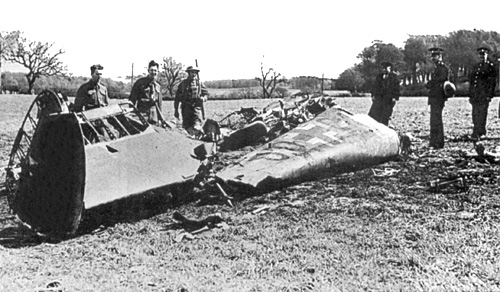 The wreckage of Hess’ plane after it had crashed in Scotland, May 10th, 1941. Source: Imperial War Museum..
The wreckage of Hess’ plane after it had crashed in Scotland, May 10th, 1941. Source: Imperial War Museum..Sentence and imprisonment
The Nuremberg trial
On October 10, 1945, Hess was transferred to Germany. In 1946 he stood trial along with other Nazi leaders before the Internationl Military Tribunal in Nuremberg. Prior to the trial, he was examined by psychiatrist Douglas Kelly. Kelly concluded Hess was mentally sane, although he did label him as a very neurotic, hysteric person. About Hess he declared: "If you consider the street healthy and the sidewalk unhealthy, then Hess is standing on the kerbside most of the time." During the trial, Hess often seemed mentally absent. During the proceedings he usually read a book or he just sat staring into space. He usually answered questions by the judges by saying he could no longer remember. He gave the impression he was suffering from amnesia. Later on he contradicted this and claimed that this simulated amnesia had been just a tactic of his. He hoped to be declared unanswerable to his actions and so evade the death penalty. Confronted with the atrocities that had taken place in the concentrationcamps, he claimed that this was Allied propaganda. He later claimed campguards had been hypnotized by Jews and so had come to their actions.
During the proceedings, the main prosecutor at the trial, Robert H. Jackson, described Hess as follows:"The fanatic Hess was the engineer of the party machine before he succumbed to an appetite for travel (he flew to Scotland in May 1941). He passed orders and propaganda to the partyleadership. He directed all aspects of party activities and maintained the organization as a loyal instrument of power."
The judges of the tribunal recognized that Hess displayed erratic behaviour and that he deteriorated mentally. Nothing indicated however that he did not understand the charges or that he, at the time the crimes he was charged with had been committed, was unanswerable for his actions; consequently, the court saw no reason whatsoever to assume Hess could not be held accountable. In the end he was found guilty of two of the four charges of the indictment, namely: Conspiracy to wage aggressive warfare or crimes against peace and waging of an aggressive war.
The fact that Hess showed no repentance whatsoever for his actions probably did not do his situation any good. In his closing statement he said for instance:"It was granted to me to work many years of my life under the greatest son my people have ever produced in its thousand years of history. Even if I could, I would not want to eradicate this period from my memory. I am happy to know that I did my duty on behalf of my people, my duty as a German, as a Nationalsocialist, as a true follower of my Führer. I regret nothing". In the end, Hess was sentenced to life imprisonment.
Spandau and his death
To serve his sentence, Hess was transferred to Spandau prison in Berlin on July 1947 where he was henceforth designated as prisoner number 7. In Spandau, a rather strict regime was maintained, especially during the first years. A strict daily routine was enforced, one letter was allowed to be sent only once every four weeks and contact between prisoners was limited to a minimum. During his imprisonment, Hess occupied himself with reading (mainly historic and scientific works), writing letters and working in the prison garden.
Prisoner number 7 continued to behave as a paranoid. He was convinced people wanted to poison him and therefore he often refused his own portion of food. He also often complained he suffered from unbearable pains. Initially he was treatd for this, later on he was administered only placebos. He often started yelling in the middle of the night, very much to the discomfort of his fellow prisoners and the guards. Furthermore, he refused to receive his family for years because he did not agree with the circumstances under which these visits should take place. He also was afraid that this reunion would be emotionally too heavy a burden for both parties. On November 26, 1959, Hess tried to committ suicide by cutting his wrists with a piece of broken glass from his spectacles. He was left with only slight injuries.
Although others who had been sentenced in Nurnberg, such as Konstantin von Neurath (1954), Erich Raeder (1955) ) and Walter Funk (1957) were released rather soon, all pleas for the release of Rudolf Hess by his lawyer, Dr. Alfred Seidl were rejected each and every time.As early as 1950, Churchill declared that he was happy not to be responsible anymore for the way, Rudolf Hess was treated; after all he was no longer Prime Minister. Even if he had taken on a moral guilt by standing next to Hitler, Hess had already atoned for this "devoted and thoughtless action by a benevolent insane. He came to us of his own free will and although without any power, he had some of the qualities of an envoy. His case should be treated as a medical case and not as a penal case."
The Soviet Union insisted however that where Hess was concerned, a life sentence should be a real life sentence. One of the possible reasons for this was that Hess, at the time of his flight to Scotland, already knew about the imminent attack on the Soviet Union (Operation Barbarossa) and that he had approved this. Another point was that Hess had held a high position within the Nazi regime, making him a role model in the eyes of the Soviets.
The regime of Hess’ imprisonment however became more relaxed at the end of the sixties. He moved into a larger cell, he did not have to work anymore and he gained much freedom within the prison. On October 1st, 1966, Albert Speer and Baldur von Schirach were discharged from Spandau prison. From that moment on, Hess was the sole prisoner in a jail with 600 cells. The cost for his imprisonment rose to 800,000 Mark a year. In Decembver 1969, his wife Ilse and his son Wolf Rüdiger visited him for the first time. At that moment, he had been admitted to a British military hospital in West-Berlin to be treated for a perforated ulcer and intestinal complaints. In January 1970, he returned to Spandau. Despite many persons speaking out in favour of the release of Hess, including Winston Churchill, Willy Brandt (German federal chancellor at the time) and Hartley Shawcross (the prosecutor for Great-Britain during the Nurnberg trial), the Soviet Union remained adamant.
On February 22, 1977, Hess made yet another attempt at suicide. This time he cut his wrists with a knife and again he survived. In the end, on August 17th, 1987, 93 year old Hess was found dead in a garden house on the premises of the prison. He had hung himself with a power cable. The official version was suicide which became apparent, among other things, from a letter of farewell that was discovered near his body. A number of people, including his son, claimed he had been murdered on orders from the British because he allegedly knew too much about the negotiations between Germany and Great-Britain during World War Two. However, despite two post mortems and other intensive research, nothing was ever discovered to corroborate this theory.
At his own request, Rudolf Hess was buried in the graveyard of Wunsiedel, the town in Bavaria his family originally came from and where in the past his parents had owned a summerhouse in the neighbourhood. Hess’ grave evolved into some sort of place of pilgrimage of neo Nazis who organized large manifestations there on August 17, each year, the day of his death. Owing to these events his grave was cleared on July 20, 2011, when the rent had almost expired. With permission from the family, the remains were cremated and the ashes dispersed over the sea.
In 1992, the larger part of the British files on Rudolf Hess were declassified. His wife Ilse, who had been arrested on June 3, 1947 and released on March 23, 1948, passed away in 1995; her funeral was attended by Gudrun Himmler, Ilsebill Todt, Wolf Rüdiger Hess and Martin Bormann junior. Wolf Rüdiger Hess passed away on October 24th, 2001.
Definitielijst
- Führer
- German word for leader. During his reign of power Adolf Hitler was Führer of Nazi Germany.
- Jews
- Middle Eastern people with own religion that lived in Palestine. They distinguished themselves by their strong monotheism and the strict observance of the Law and tradition. During World War 2 the Jewish people were ruthlessly persecuted and annihilated by the German Nazis. . An estimated 6,000,000 Jews were exterminated.
- moral
- The will of the troops/civilians to keep fighting.
- Nazi
- Abbreviation of a national socialist.
- propaganda
- Often misleading information used to gain support among supporters or to gain support. Often used to accomplish ideas and political goals.
- Soviet Union
- Soviet Russia, alternative name for the USSR.
Images
Epilogue
Rumours
After the Second World War, there have been many theories as to why Hess made his flight to Scotland. Some argue that Hitler was well aware of Hess’ plans and that he wanted to make peace with Great-Britain at all costs. According to this theorie, Churchill may have refused to negotiate because he knew that the United States and the Soviet Union would soon be involved in the war. There are also people who claim that Hess may have been lured to Great-Britain by the British Secret Service by means of a simulated attempt at reconcilliation by the British politician Lord Halifax (aka Lord Haw Haw). This action would have embarassed the Führer. As Hitler would get the idea that Great-Britain was open to negotiations, the country would get a delay of a few months to recuperate from the losses already suffered. Moreover, by these negotiations, Hitler would gain enough self-confidence to launch an attack on the Soviet Union. One of the persons who may have been involved in these operations was Ian Fleming, the creator of James Bond. One of the advocates of this theory is Martin Allen who tries to convince the reader of his credibility in his book "The Hitler-Hess scam - the best kept secret of the Second World War". However, no conclusive evidence has ever been presented for all of these wild speculations.
It is even suggested that the man who spent years in Spandau prison in Berlin could never have been Rudolf Hess but must have been a double. One of the books on this subject is by Hugh Thomas, who was employed at the British Military hospital as surgeon general from 1972 to 1973 where he got to know the world’s most famous prisoner. He had regularly examined Hess medically and has never found the scar Hess was left with after having been shot through his chest during World War One. According to Thomas, the real Hess has been murdered by his enemies within the Nazi hierarchy.
The Dutch physiotherapist At Voorst did extensive research into this lookalike theory. Based on characteristics of body and behaviour and preferred movements he concluded that the Hess, prior to the flight to Scotland and the person in Spandau prison were almost surely one and the same man. Other physicians did find Hess’ scars that were left over from the injuries he had sustained during World War One. The bullet that had penetrated Hess’ chest had caused relatively small wounds, therefore the scars may well have been missed initially. Later on, others physicians and historians expressed doubts about Thomas‘ statements. The pathologist Professor Spann of Munich University, who performed an autopsy on Hess concluded irrefutably that the man he had examined, was Rudolf Hess.
Hess undertook his trip to England most probably without Hitler being aware of it. He was an idealist and moreover, somewhat naïve, probably on the brink of a nervous breakdown. He may have really thought he could make peace with Great-Britain so they could join battle together against the Soviet Union. By this act, he would also enjoy Hitler’s favour again, something he desperately wished for. Despite the fact that there are many theories that contradict this official version, yet conclusive evidence to the contrary has never been presented. It cannot be entirely excluded that the British Secret Service played a part in this story. A number of files will only be declassified in 2017 and then, this puzzle can be finally solved. Then it also may become clear what kind of negotiations may have been conducted between Great-Britain and Germany.
Even today, there is still much debate over Hess’ mental condition. It was well enough to to complete the flight to Scotland; an enterprise that displayed a sound mind and professional ability, acoording to friend and foe alike. It is obvious however that mentally speaking, he was not well, the psychological records are clear about this. It is unclear however where the real disorders ended and the simulated ones began as it is also obvious that Hess frequently simulated something or other and then mainly amnesia.
Rudolf Hess is and will remain a conspicuous figure. His flight to Scotland keeps minds busy. There are many theories of conspiracy about this event but incontrovertible evidence to the effect that it all really happened contrary to the official version has never been presented. To one person he is an idealist, to another a pawn in a shady political game and to yet another an unstable figure. The most important fact however is that he played a major role in establishing the Third Reich, especially in the pre war years and at the start of the Nazi period. Above all, he should be considered a fanatical Nationalsocialist and a dedicated follower of the Führer.
Also see: Final statement Hess, Verdict Hess
Definitielijst
- Führer
- German word for leader. During his reign of power Adolf Hitler was Führer of Nazi Germany.
- Nazi
- Abbreviation of a national socialist.
- Soviet Union
- Soviet Russia, alternative name for the USSR.
Images
Information
- Article by:
- Wesley Dankers
- Translated by:
- Arnold Palthe
- Published on:
- 19-01-2025
- Feedback?
- Send it!
- 10-'46: Judgement at Nuremberg
The War Illustrated
Related sights
Sources
- Bericht van de Tweede Wereldoorlog, Amsterdam Boek, Amsterdam, 1970.
- BOER, S. DE, De Hitler Mythes, Just Publishers, Meppel, 2015.
- HAFFNER, S., Kanttekeningen bij Hitler, Becht Uitgevers-maatschappij, Amsterdam, 1978.
- KERSHAW, I., Hitler - Hoogmoed 1889-1936, Het Spectrum, Utrecht, 2003.
- KNOPP, G., Hitlers beulen, de Prom, Baarn, 2001.
- MANVELL, R., Rudolf Hess, In den Toren, Baarn, 1972.
- MISCH, R., De laatste getuige, Just Publishers, Meppel, 2014.
- SHIRER, W., Opkomst en Ondergang van het Derde Rijk, Becht Uitgevers-Maatschappij, Amsterdam, 1959.
- THOMAS, HUGH, Mei 1941: De liquidatie van Rudolf Hess, Elsevier, Amsterdam, 1979.
- VOORHORST, A., Dubbelgangers ontmaskerd, 2010.
- KESSELER, A., "Complot: vlucht voor de vrede", Kijk, juni 2006.
- Hitlers Derde Rijk, Nationale Handels Onderneming (NHA), Panningen, 2002-2003.
- de.wikipedia.org
- en.wikipedia.org
- en.wikiquote.org
- Historisch Nieuwsblad
- Rudolf Hess: The Truth Behind His Flight to Britain
- STIWOT Forum
Thanks to Hans Molier whose original article, published here, has been a valuable source in writing this version.
